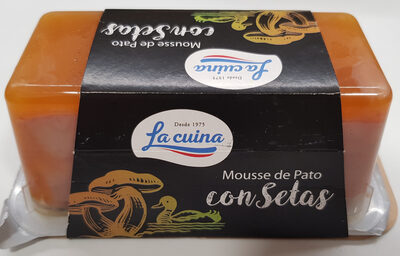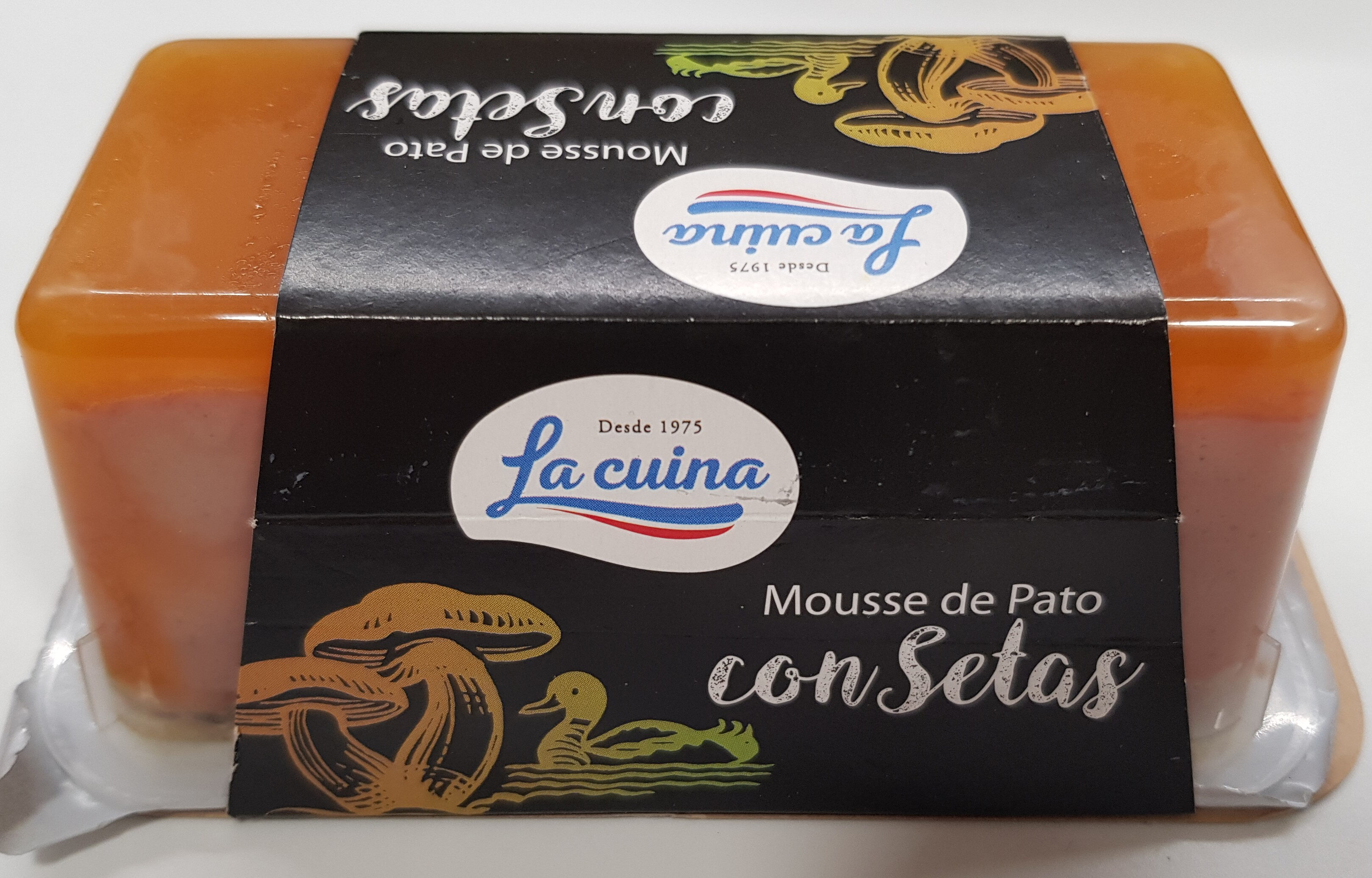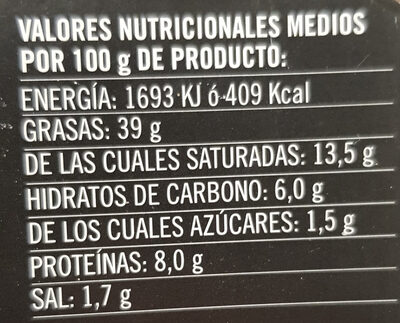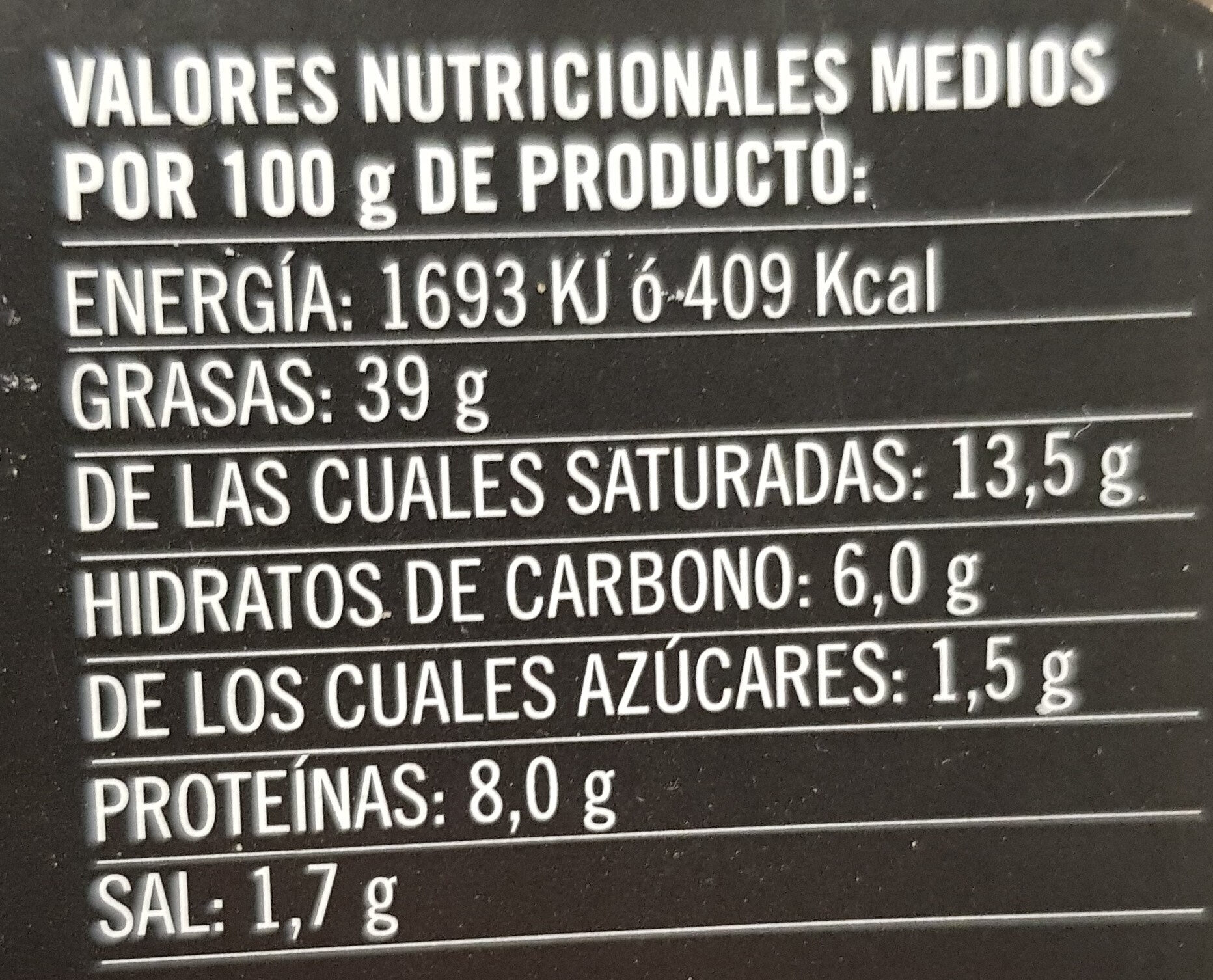Ajuda'ns a fer que la transparència alimentària sigui la norma!
Com a organització sense ànim de lucre, depenem de les vostres donacions per continuar informant els consumidors de tot el món sobre tot allò què mengen.
La revolució alimentària comença amb tu!
Mousse de Pato con Setas - la cuina - 190 g
Mousse de Pato con Setas - la cuina - 190 g
Aquesta pàgina del producte no està completa. Podeu ajudar a completar-la editant-la i afegint-hi més dades a partir de les fotos ja disponibles, o fent-ne més amb l'aplicació de androide o iPhone / iPad. Gràcies!
×
Codi de barres: 8411763133669 (EAN / EAN-13)
Quantitat: 190 g
Marques: la cuina
Categories: Productes amb base de carn, Menjar preparat, Aliments amb carn, Menjars d'aus de corral, en:Duck dishes
Etiquetes, certificacions, premis: Lliure de gluten
Llocs de fabricació o processament: Valencia, España
Codi de traçabilitat: ES 10.01068/V CE
Països on es va vendre: Espanya
Matching with your preferences
Salut
Ingredients
-
51 ingredients
: paté (hígado y grasa de pato 38 %, grasa de cerdo, agua, hígado de pollo, almidón, setas 2.2% (Cratherellus cornucopioides), sólidos lácteos (leche), clara de huevo, sal, aromas naturales, vino dulce aromatizado, cebolla, gelatina de cerdo, dextrosa, especias, estabilizante E339ii, estabilizante E339iii, corrector de acidez E262i, antioxidantes E316, antioxidantes E331, conservador E250), decoración (agua, Pedro Ximénez, azúcar, correctores de acidez E331, correctores de acidez E262i, correctores de acidez E330, correctores de acidez E340, gelificante E407, gelificante E440i, gelificante E410, dextrosa, colorante E150).Al·lèrgens: en:Eggs, en:MilkRastres: en:Nuts, en:Sesame seeds
Processament d'aliments
-
Aliments ultra processats
Elements que indiquen que el producte està al grup 4 - Aliments i begudes ultraprocessats:
- Additiu: E150 - Caramel
- Additiu: E407 - Carragahen
- Additiu: E410 - Goma de garrofí
- Additiu: E428 - Gelatina
- Additiu: E440 - Pectina
- Ingredient: Color
- Ingredient: Dextrosa
- Ingredient: Aromes
- Ingredient: Gelificant
- Ingredient: Glucosa
Els productes alimentaris es classifiquen en 4 grups segons el seu grau de processament:
- Aliments no processats o mínimament processats
- Ingredients culinaris processats
- Aliments processats
- Aliments ultra processats
La determinació del grup es fa en funció de la categoria del producte i dels ingredients que conté.
Additius
-
E250 - Nitrit de sodi
Sodium nitrite: Sodium nitrite is the inorganic compound with the chemical formula NaNO2. It is a white to slightly yellowish crystalline powder that is very soluble in water and is hygroscopic. It is a useful precursor to a variety of organic compounds, such as pharmaceuticals, dyes, and pesticides, but it is probably best known as a food additive to prevent botulism. It is on the World Health Organization's List of Essential Medicines, the most important medications needed in a basic health system.Nitrate or nitrite -ingested- under conditions that result in endogenous nitrosation has been classified as "probably carcinogenic to humans" by International Agency for Research on Cancer -IARC-.Origen: Wikipedia (Anglès)
-
E262 - Acetats de sodi
Sodium acetate: Sodium acetate, CH3COONa, also abbreviated NaOAc, is the sodium salt of acetic acid. This colorless deliquescent salt has a wide range of uses.Origen: Wikipedia (Anglès)
-
E262i - Acetat de sodi
Sodium acetate: Sodium acetate, CH3COONa, also abbreviated NaOAc, is the sodium salt of acetic acid. This colorless deliquescent salt has a wide range of uses.Origen: Wikipedia (Anglès)
-
E316 - Eritorbat de sodi
Sodium erythorbate: Sodium erythorbate -C6H7NaO6- is a food additive used predominantly in meats, poultry, and soft drinks. Chemically, it is the sodium salt of erythorbic acid. When used in processed meat such as hot dogs and beef sticks, it increases the rate at which nitrite reduces to nitric oxide, thus facilitating a faster cure and retaining the pink coloring. As an antioxidant structurally related to vitamin C, it helps improve flavor stability and prevents the formation of carcinogenic nitrosamines. When used as a food additive, its E number is E316. The use of erythorbic acid and sodium erythorbate as a food preservative has increased greatly since the U.S. Food and Drug Administration banned the use of sulfites as preservatives in foods intended to be eaten fresh -such as ingredients for fresh salads- and as food processors have responded to the fact that some people are allergic to sulfites. It can also be found in bologna, and is occasionally used in beverages, baked goods, and potato salad.Sodium erythorbate is produced from sugars derived from different sources, such as beets, sugar cane, and corn. An urban myth claims that sodium erythorbate is made from ground earthworms; however, there is no truth to the myth. It is thought that the genesis of the legend comes from the similarity of the chemical name to the words earthworm and bait.Alternative applications include the development of additives that could be utilized as anti-oxidants in general. For instance, this substance has been implemented in the development of corrosion inhibitors for metals and it has been implemented in active packaging.Sodium erythorbate is soluble in water. The pH of the aqueous solution of the sodium salt is between 5 and 6. A 10% solution, made from commercial grade sodium erythorbate, may have a pH of 7.2 to 7.9. In its dry, crystalline state it is nonreactive. But, when in solution with water it readily reacts with atmospheric oxygen and other oxidizing agents, which makes it a valuable antioxidant.Origen: Wikipedia (Anglès)
-
E330 - Acid citric
Citric acid: Citric acid is a weak organic acid that has the chemical formula C6H8O7. It occurs naturally in citrus fruits. In biochemistry, it is an intermediate in the citric acid cycle, which occurs in the metabolism of all aerobic organisms. More than a million tons of citric acid are manufactured every year. It is used widely as an acidifier, as a flavoring and chelating agent.A citrate is a derivative of citric acid; that is, the salts, esters, and the polyatomic anion found in solution. An example of the former, a salt is trisodium citrate; an ester is triethyl citrate. When part of a salt, the formula of the citrate ion is written as C6H5O3−7 or C3H5O-COO-3−3.Origen: Wikipedia (Anglès)
-
E331 - Citrats de sodi
Sodium citrate: Sodium citrate may refer to any of the sodium salts of citrate -though most commonly the third-: Monosodium citrate Disodium citrate Trisodium citrateThe three forms of the salt are collectively known by the E number E331. Sodium citrates are used as acidity regulators in food and drinks, and also as emulsifiers for oils. They enable cheeses to melt without becoming greasy.Origen: Wikipedia (Anglès)
-
E339 - Fosfati de sodi
Sodium phosphates: Sodium phosphate is a generic term for a variety of salts of sodium -Na+- and phosphate -PO43−-. Phosphate also forms families or condensed anions including di-, tri-, tetra-, and polyphosphates. Most of these salts are known in both anhydrous -water-free- and hydrated forms. The hydrates are more common than the anhydrous forms.Origen: Wikipedia (Anglès)
-
E339ii
Sodium phosphates: Sodium phosphate is a generic term for a variety of salts of sodium -Na+- and phosphate -PO43−-. Phosphate also forms families or condensed anions including di-, tri-, tetra-, and polyphosphates. Most of these salts are known in both anhydrous -water-free- and hydrated forms. The hydrates are more common than the anhydrous forms.Origen: Wikipedia (Anglès)
-
E339iii - Fosfat de trisodi
Sodium phosphates: Sodium phosphate is a generic term for a variety of salts of sodium -Na+- and phosphate -PO43−-. Phosphate also forms families or condensed anions including di-, tri-, tetra-, and polyphosphates. Most of these salts are known in both anhydrous -water-free- and hydrated forms. The hydrates are more common than the anhydrous forms.Origen: Wikipedia (Anglès)
-
E340 - Fosfat de potassi
Potassium phosphate: Potassium phosphate is a generic term for the salts of potassium and phosphate ions including: Monopotassium phosphate -KH2PO4- -Molar mass approx: 136 g/mol- Dipotassium phosphate -K2HPO4- -Molar mass approx: 174 g/mol- Tripotassium phosphate -K3PO4- -Molar mass approx: 212.27 g/mol-As food additives, potassium phosphates have the E number E340.Origen: Wikipedia (Anglès)
-
E407 - Carragahen
Carrageenan: Carrageenans or carrageenins - karr-ə-gee-nənz, from Irish carraigín, "little rock"- are a family of linear sulfated polysaccharides that are extracted from red edible seaweeds. They are widely used in the food industry, for their gelling, thickening, and stabilizing properties. Their main application is in dairy and meat products, due to their strong binding to food proteins. There are three main varieties of carrageenan, which differ in their degree of sulfation. Kappa-carrageenan has one sulfate group per disaccharide, iota-carrageenan has two, and lambda-carrageenan has three. Gelatinous extracts of the Chondrus crispus -Irish moss- seaweed have been used as food additives since approximately the fifteenth century. Carrageenan is a vegetarian and vegan alternative to gelatin in some applications or may be used to replace gelatin in confectionery.Origen: Wikipedia (Anglès)
-
E410 - Goma de garrofí
Locust bean gum: Locust bean gum -LBG, also known as carob gum, carob bean gum, carobin, E410- is a thickening agent and a gelling agent used in food technology.Origen: Wikipedia (Anglès)
-
E440 - Pectina
Pectin: Pectin -from Ancient Greek: πηκτικός pēktikós, "congealed, curdled"- is a structural heteropolysaccharide contained in the primary cell walls of terrestrial plants. It was first isolated and described in 1825 by Henri Braconnot. It is produced commercially as a white to light brown powder, mainly extracted from citrus fruits, and is used in food as a gelling agent, particularly in jams and jellies. It is also used in dessert fillings, medicines, sweets, as a stabilizer in fruit juices and milk drinks, and as a source of dietary fiber.Origen: Wikipedia (Anglès)
-
E440i - Pectina no amidada
Pectin: Pectin -from Ancient Greek: πηκτικός pēktikós, "congealed, curdled"- is a structural heteropolysaccharide contained in the primary cell walls of terrestrial plants. It was first isolated and described in 1825 by Henri Braconnot. It is produced commercially as a white to light brown powder, mainly extracted from citrus fruits, and is used in food as a gelling agent, particularly in jams and jellies. It is also used in dessert fillings, medicines, sweets, as a stabilizer in fruit juices and milk drinks, and as a source of dietary fiber.Origen: Wikipedia (Anglès)
Anàlisi dels ingredients
-
Pot contenir oli de palma
Ingredients que poden contenir oli de palma: en:Duck fat, en:Pork fat
-
No és vegà
Ingredients no vegans: en:Liver, en:Duck fat, en:Pork fat, en:Chicken liver, en:Milk solids, Clara d'ou, Gelatina de porcAlguns ingredients no s'han pogut reconèixer.
Necessitem la teva ajuda!
Podeu ajudar-nos a reconèixer més ingredients i analitzar millor la llista d'ingredients d'aquest producte i d'altres mitjançant:
- Editeu aquesta pàgina de producte per corregir les faltes d’ortografia de la llista d’ingredients i/o per eliminar els ingredients d’altres idiomes i frases que no estiguin relacionades amb els ingredients.
- Afegiu entrades, sinònims o traduccions noves a les nostres llistes multilingües d’ingredients, mètodes de processament d’ingredients i etiquetes.
Uniu-vos al canal #ingredients del nostre espai de discussió a Slack i/o apreneu sobre l'anàlisi dels ingredients en la nostra wiki, si voleu ajudar. Gràcies!
-
No és vegetarià
Ingredients no vegetarians: en:Liver, en:Duck fat, en:Pork fat, en:Chicken liver, Gelatina de porcAlguns ingredients no s'han pogut reconèixer.
Necessitem la teva ajuda!
Podeu ajudar-nos a reconèixer més ingredients i analitzar millor la llista d'ingredients d'aquest producte i d'altres mitjançant:
- Editeu aquesta pàgina de producte per corregir les faltes d’ortografia de la llista d’ingredients i/o per eliminar els ingredients d’altres idiomes i frases que no estiguin relacionades amb els ingredients.
- Afegiu entrades, sinònims o traduccions noves a les nostres llistes multilingües d’ingredients, mètodes de processament d’ingredients i etiquetes.
Uniu-vos al canal #ingredients del nostre espai de discussió a Slack i/o apreneu sobre l'anàlisi dels ingredients en la nostra wiki, si voleu ajudar. Gràcies!
-
Detalls de l'anàlisi dels ingredients
Necessitem la teva ajuda!
Alguns ingredients no s'han pogut reconèixer.
Necessitem la teva ajuda!
Podeu ajudar-nos a reconèixer més ingredients i analitzar millor la llista d'ingredients d'aquest producte i d'altres mitjançant:
- Editeu aquesta pàgina de producte per corregir les faltes d’ortografia de la llista d’ingredients i/o per eliminar els ingredients d’altres idiomes i frases que no estiguin relacionades amb els ingredients.
- Afegiu entrades, sinònims o traduccions noves a les nostres llistes multilingües d’ingredients, mètodes de processament d’ingredients i etiquetes.
Uniu-vos al canal #ingredients del nostre espai de discussió a Slack i/o apreneu sobre l'anàlisi dels ingredients en la nostra wiki, si voleu ajudar. Gràcies!
: paté (hígado, grasa de pato 38%, grasa de cerdo, agua, hígado de pollo, almidón, setas 2.2% (Cratherellus cornucopioides), sólidos lácteos, clara de _huevo_, sal, aromas naturales, vino dulce aromatizado, cebolla, gelatina de cerdo, dextrosa, especias, estabilizante (e339ii), estabilizante (e339iii), corrector de acidez (e262i), antioxidantes (e316), antioxidantes (e331), conservador (e250)), decoración (agua, Pedro Ximénez, azúcar, correctores de acidez (e331), correctores de acidez (e262i), correctores de acidez (e330), correctores de acidez (e340), gelificante (e407), gelificante (e440i), gelificante (e410), dextrosa, colorante (e150))- paté -> es:pate
- hígado -> en:liver - vegan: no - vegetarian: no
- grasa de pato -> en:duck-fat - vegan: no - vegetarian: no - from_palm_oil: maybe - ciqual_food_code: 16550 - percent: 38
- grasa de cerdo -> en:pork-fat - vegan: no - vegetarian: no - from_palm_oil: maybe - ciqual_food_code: 16530
- agua -> en:water - vegan: yes - vegetarian: yes - ciqual_food_code: 18066
- hígado de pollo -> en:chicken-liver - vegan: no - vegetarian: no - ciqual_food_code: 40111
- almidón -> en:starch - vegan: yes - vegetarian: yes - ciqual_proxy_food_code: 9510
- setas -> en:mushroom - vegan: yes - vegetarian: yes - ciqual_food_code: 20010 - percent: 2.2
- Cratherellus cornucopioides -> es:cratherellus-cornucopioides
- sólidos lácteos -> en:milk-solids - vegan: no - vegetarian: yes - ciqual_proxy_food_code: 19051
- clara de _huevo_ -> en:egg-white - vegan: no - vegetarian: yes - ciqual_food_code: 22001
- sal -> en:salt - vegan: yes - vegetarian: yes - ciqual_food_code: 11058
- aromas naturales -> en:natural-flavouring - vegan: maybe - vegetarian: maybe
- vino dulce aromatizado -> es:vino-dulce-aromatizado
- cebolla -> en:onion - vegan: yes - vegetarian: yes - ciqual_food_code: 20034
- gelatina de cerdo -> en:pork-gelatin - vegan: no - vegetarian: no
- dextrosa -> en:dextrose - vegan: yes - vegetarian: yes - ciqual_proxy_food_code: 31016
- especias -> en:spice - vegan: yes - vegetarian: yes
- estabilizante -> en:stabiliser
- e339ii -> en:e339ii
- estabilizante -> en:stabiliser
- e339iii -> en:e339iii - vegan: yes - vegetarian: yes
- corrector de acidez -> en:acidity-regulator
- e262i -> en:e262i - vegan: yes - vegetarian: yes
- antioxidantes -> en:antioxidant
- e316 -> en:e316 - vegan: yes - vegetarian: yes
- antioxidantes -> en:antioxidant
- e331 -> en:e331 - vegan: yes - vegetarian: yes
- conservador -> en:preservative
- e250 -> en:e250 - vegan: yes - vegetarian: yes
- decoración -> es:decoracion
- agua -> en:water - vegan: yes - vegetarian: yes - ciqual_food_code: 18066
- Pedro Ximénez -> es:pedro-ximenez
- azúcar -> en:sugar - vegan: yes - vegetarian: yes - ciqual_proxy_food_code: 31016
- correctores de acidez -> en:acidity-regulator
- e331 -> en:e331 - vegan: yes - vegetarian: yes
- correctores de acidez -> en:acidity-regulator
- e262i -> en:e262i - vegan: yes - vegetarian: yes
- correctores de acidez -> en:acidity-regulator
- e330 -> en:e330 - vegan: yes - vegetarian: yes
- correctores de acidez -> en:acidity-regulator
- e340 -> en:e340 - vegan: yes - vegetarian: yes
- gelificante -> en:gelling-agent
- e407 -> en:e407 - vegan: yes - vegetarian: yes
- gelificante -> en:gelling-agent
- e440i -> en:e440i - vegan: yes - vegetarian: yes
- gelificante -> en:gelling-agent
- e410 -> en:e410 - vegan: yes - vegetarian: yes
- dextrosa -> en:dextrose - vegan: yes - vegetarian: yes - ciqual_proxy_food_code: 31016
- colorante -> en:colour
- e150 -> en:e150 - vegan: yes - vegetarian: yes
Nutrició
-
Mala qualitat nutricional
⚠ ️Atenció: la quantitat de fibra no s'especifica, no es tindrà en compte la seva possible contribució positiva en la qualificació.⚠ ️Atenció: la quantitat de fruita, verdura i fruits secs no s'especifica a l'etiqueta, s'ha fet una estimació a partir de la llista d'ingredients: 2Aquest producte no es considera una beguda per al càlcul de la Nutri-Score.
Punts positius: 0
- Proteïnes: 4 / 5 (valor: 8, valor arrodonit: 8)
- Fibra: 0 / 5 (valor: 0, valor arrodonit: 0)
- Fruites, verdures, fruits secs i olis de colza/nou/oliva: 0 / 5 (valor: 2.2, valor arrodonit: 2.2)
Punts negatius: 22
- Energia: 5 / 10 (valor: 1693, valor arrodonit: 1693)
- Sucres: 0 / 10 (valor: 1.5, valor arrodonit: 1.5)
- Greixos saturats: 10 / 10 (valor: 13.5, valor arrodonit: 13.5)
- Sodi: 7 / 10 (valor: 680, valor arrodonit: 680)
Els punts per proteïnes no es compten perquè els punts negatius són més o iguals a 11.
Puntuació nutricional: (22 - 0)
Nutri-Score:
-
Nivells de nutrients
-
Greix en alta quantitat (39%)
Què us cal saber- Un alt consum de greixos, especialment de greixos saturats, pot augmentar el colesterol, que augmenta el risc de patir malalties del cor.
Recomanació: Reduïu el consum de greixos i greixos saturats- Trieu productes amb menys greixos i greixos saturats.
-
Àcid gras saturat en alta quantitat (13.5%)
Què us cal saber- Un alt consum de greixos, especialment de greixos saturats, pot augmentar el colesterol, que augmenta el risc de patir malalties del cor.
Recomanació: Reduïu el consum de greixos i greixos saturats- Trieu productes amb menys greixos i greixos saturats.
-
Sucre en baixa quantitat (1.5%)
Què us cal saber- Un alt consum de sucre pot provocar augment de pes i càries dental. També augmenta el risc de patir diabetis tipus 2 i malalties cardiovasculars.
Recomanació: Limitau el consum de sucre i de begudes ensucrades- Les begudes ensucrades (com ara refrescos, begudes de fruites i sucs i nèctars de fruites) s'han de limitar tant com sigui possible (no més d'1 got al dia).
- Triau productes amb menor contingut de sucre i reduïu el consum de productes amb sucres afegits.
-
Sal comuna en alta quantitat (1.7%)
Què us cal saber- Un alt consum de sal (o sodi) pot provocar un augment de la pressió arterial, que pot augmentar el risc de patir malalties del cor i ictus.
- Moltes persones que tenen hipertensió no ho saben, ja que sovint no en tenen símptomes.
- La majoria de la gent consumeix massa sal (de 9 a 12 grams de mitjana al dia), al voltant del doble del nivell màxim d'ingesta recomanat.
Recomanació: Limitau la ingesta de sal i d'aliments rics en sal- Reduïu la sal que emprau quan cuinau, i no afegiu sal a taula.
- Limiteu el consum d'aperitius salats i trieu productes amb menor contingut de sal.
-
-
Informació nutricional
Informació nutricional Com es ven
per 100 g/100 mlComparat amb: en:Duck dishes Energia 1.693 kj
(405 kcal)+27% Greix 39 g +54% Àcid gras saturat 13,5 g +60% Hidrats de carboni 6 g +15% Sucre 1,5 g -21% Fiber ? Proteïna 8 g -28% Sal comuna 1,7 g +32% Fruits‚ vegetables‚ nuts and rapeseed‚ walnut and olive oils (estimate from ingredients list analysis) 2,2 %
Entorn
-
Eco-puntuació E - Impacte ambiental molt alt
El Eco-Score és una puntuació experimental que resumeix els impactes ambientals dels productes alimentaris.→ L'Eco-Score es va desenvolupar inicialment a França i s'està ampliant per a altres països europeus. La fórmula Eco-Score està subjecta a canvis, ja que es millora periòdicament per fer-la més precisa i més adequada per a cada país.Anàlisi del cicle de vida
-
Impacte mitjà dels productes de la mateixa categoria: D (Score: 36/100)
Categoria: Duck with sauce (green pepper sauce, hunter-style sauce,etc.)
Categoria: Duck with sauce (green pepper sauce, hunter-style sauce,etc.)
- Puntuació ambiental PEF ( petjada ambiental de l'aliment ): 0.85 (com més baixa sigui la puntuació, menor serà l'impacte)
- incloent l'impacte sobre el canvi climàtic: 6.38 kg CO₂ eq/kg del producte
Etapa Impacte Agricultura
79.7 %Processament
13.7 %Empaquetament
1.8 %Transport
2.9 %Distribució
1.1 %Consum
0.8 %
Bonificacions i punts negatius
-
Falta informació sobre l'origen dels ingredients
Punts negatius: -5
⚠ ️ L'origen dels ingredients d'aquest producte no està indicat.
Si estan indicats a l'embalatge, podeu modificar la fitxa del producte i afegir-los.
Si sou el fabricant d'aquest producte, podeu enviar-nos la informació amb la nostra plataforma gratuïta per a productors.
-
Falta informació sobre l'embalatge d'aquest producte
Punts negatius: -15
⚠ ️ La informació sobre l'embalatge d'aquest producte no està completada.⚠ ️ Per a un càlcul més precís de l'Eco-Score, podeu modificar la pàgina del producte i afegir-los.
Si sou el fabricant d'aquest producte, podeu enviar-nos la informació amb la nostra plataforma gratuïta per a productors.
Eco-Score per a aquest producte
-
Impacte per a aquest producte: E (Score: 16/100)
Producte: Mousse de Pato con Setas - la cuina - 190 g
Puntuació de l'anàlisi del cicle de vida: 36
Suma de bonificacions i punts negatius: -20
Puntuació final: 16/100
-
Petjada de carboni
-
Equivalent a conduir 3.3 km en un cotxe de gasolina
638 g de CO² per cada 100 g de producte
La xifra d'emissions de carboni prové de la base de dades Agribalyse d'ADEME, per a la categoria: Duck with sauce (green pepper sauce, hunter-style sauce,etc.) (Font: Base de dades ADEME Agribalyse)
Etapa Impacte Agricultura
73.9 %Processament
17.5 %Empaquetament
2.9 %Transport
4.8 %Distribució
0.6 %Consum
0.3 %
Empaquetament
-
Falta informació sobre l'embalatge d'aquest producte
⚠ ️ La informació sobre l'embalatge d'aquest producte no està completada.Take a photo of the recycling information Take a photo of the recycling information
Transport
-
Orígens dels ingredients
Falta informació sobre l'origen dels ingredients
⚠ ️ L'origen dels ingredients d'aquest producte no està indicat.
Si estan indicats a l'embalatge, podeu modificar la fitxa del producte i afegir-los.
Si sou el fabricant d'aquest producte, podeu enviar-nos la informació amb la nostra plataforma gratuïta per a productors.Add the origins of ingredients for this product Add the origins of ingredients for this product
Report a problem
-
Incomplete or incorrect information?
Category, labels, ingredients, allergens, nutritional information, photos etc.
If the information does not match the information on the packaging, please complete or correct it. Open Food Facts is a collaborative database, and every contribution is useful for all.
Fonts de dades
Producte afegit per alexrios
Última modificació de la pàgina del producte per thaialagata.
La pàgina del producte, també editada per openfoodfacts-contributors.










